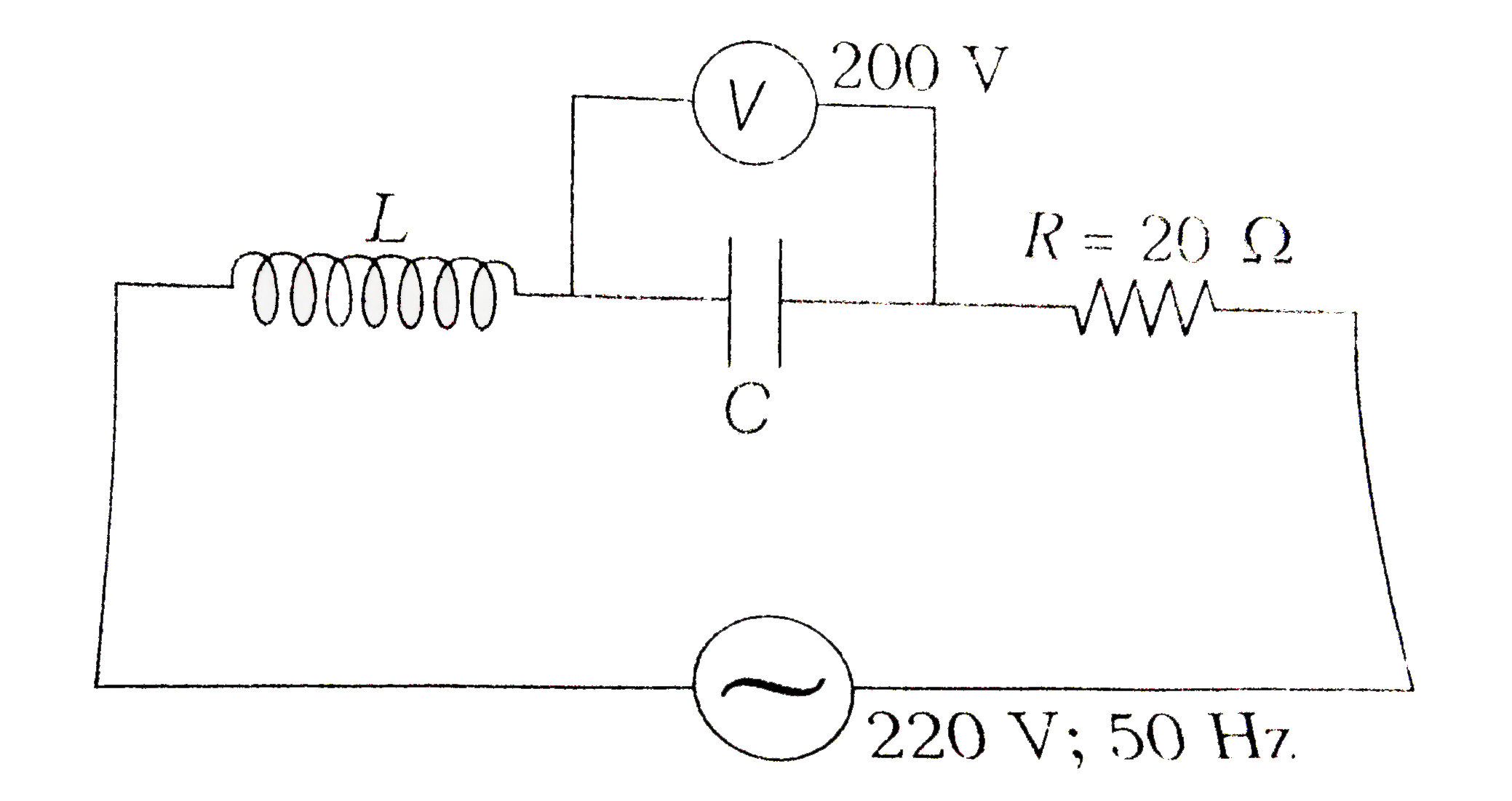In a series LCR circuit with an AC source, R=300Ω,C=20μF,L=1.0henry,εrms=50V and v=50πHz. Find (a) the rms current in the circuit and (b) the rms potential differences across the capacitor, the resistor and the inductor. Note that the sum of the rms potential differences across the three elements is greater than the rms voltage of the source.Solution in Gujrati
Given R=300Ω, C=20μF
=(20×10−6)F,
L=1Henry,
E=50V, v=50/πHz
(a) i0=E0z
and Z=√R2+(Xe−XL)2
=√(300)2+(1/2πfC−2πfL)2
=
⎷(300)2+(12π×50/π×20×10−6−2π×50π×1)2
=
⎷(300)2+(10420−100)2=500
:. i0=E0Z=50500=0.1A
(b) Potential across the capacitor
=i0×XC=0.1×500=50V
Potential difference across the resistor
=i0×R=0.1×300=30V
Potential difference across the inductor
=i0×XL=0.1×100
=10V
R.M.S. potential =50V
Net sum of all the potential drops
=50V+30V+10V
=90V
Sum of potential drops = R.m.s potential applied.
Topper's Solved these Questions
Similar Questions
An inductor, a resistor and a capacitor are joined in series with an AC source. As the frequency of the source is slightly increased from a very low value, the reactance
View SolutionThe bohrradius is given by a0=ε0h2πme2 verify that the RHS has dimesions of length
View SolutionIn a series LCR circuit with an AC source, R=300Ω,C=20μF,L=1.0henry,εrms=50V and v=50πHz. Find (a) the rms current in the circuit and (b) the rms potential differences across the capacitor, the resistor and the inductor. Note that the sum of the rms potential differences across the three elements is greater than the rms voltage of the source.
View SolutionIn the circuit shown, rms circuit is 11 A . The potential difference across the inductor is

View SolutionIn a series LCR circuit, the the rms voltage supply is 170 V. If VR,VLandVC represent the rms voltage drop across resistor , inductor and capacitor, then
View SolutionAn LCR series circuit is connected to an oscillator (AC supply) having RMS voltage 200 V. If the RMS voltages across resistor, inductor and capacitor are equal, then RMS voltage across the resistor would be
View SolutionAn AC generator 10 V ( rms ) at ( Rms ) at 200 rad //s is connected in series with a 50 Ω Resistor , a 400mH inductor and a 200μF capacitor . The rms voltage across the inductor is
View SolutionIn a series RC circuit connected across an AC source of 220 V 50 Hz calculate the rms voltage across resistor and capacitor if values of R and C are 100 Ω and 20μF respectively .
View SolutionIn a series LCR circuit with an AC source of effective voltage 50 V , frequency ν=50/π Hz R= 300ΩC=20μF and L = 1.0 H. Find the rms current in the circuit.
View SolutionIn LCR circuit R = 300 Omega, C = 20 mu F, L = 1.0 H, Alternating sources E _(“rms”) = 50 V And f = 50 //pi Hz Is organized in hierarchy. Find the value of RMS current in the circuit.
View SolutionA circuit containing a 80 mH inductor and a 60 μF capacitor in series is connected to a 230 V, 50 Hz supply. The resistance of the circuit is negligible.
(a) Obtain the current amplitude and rms values.
(b) Obtain the rms values of potential drops across each element.
(c) What is the average power transferred to the inductor?
(d) What is the average power transferred to the capacitor?
(e) What is the total average power absorbed by the circuit? [‘Average’ implies ‘averaged over one cycle’.]
View SolutionIn the LCR circuit shown,if RMS voltages across resistor inductor and capacitor are equal,the RMS value of voltage across resistor will be
View SolutionIn the circuit shown, rms circuit is 11 A . The potential difference across the inductor is
View SolutionA capacitor and resistor are connected in series with an ac source. If the potential difference across C and R are 120 V and 90V respectively and if the rms current of the circuit is 3A, calculate (i) impedance and (ii) power factor of the circuit.
View SolutionIn a series LCR circuit, the the rms voltage supply is 170 V. If V_(R), V_(L) and V_(C) represent the rms voltage drop across resistor , inductor and capacitor, then
View SolutionIn a series LCR circuit with an AC source, R=300Ω,C=20μF,L=1.0henry,εrms=50V and v=50πHz. Find (a) the rms current in the circuit and (b) the rms potential differences across the capacitor, the resistor and the inductor. Note that the sum of the rms potential differences across the three elements is greater than the rms voltage of the source.
View Solution
